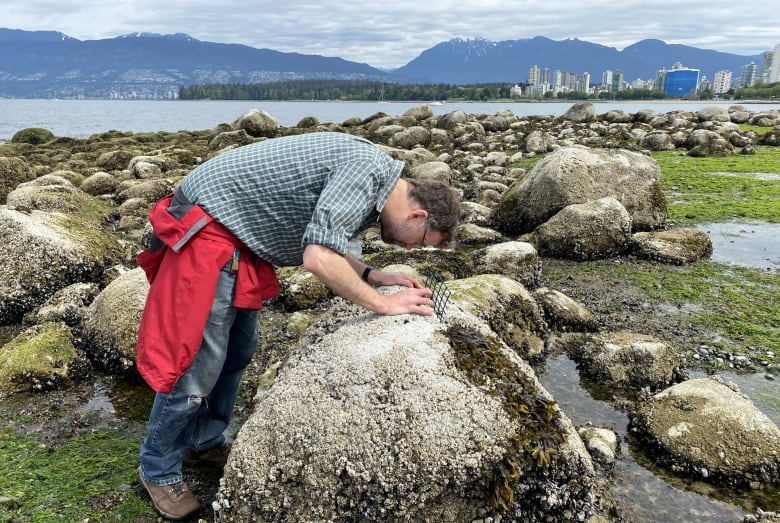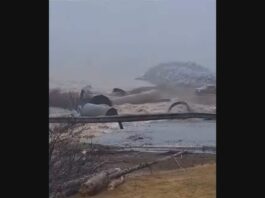
Our planet is changing. So is our journalism. This weekly newsletter is part of a CBC News initiative entitled “Our Changing Planet” to show and explain the effects of climate change. Keep up with the latest news on our Climate and Environment page.
Sign up here to get this newsletter in your inbox every Thursday.
This week:
- The 2021 heat dome in B.C. had wide-ranging impacts on marine life, scientists say
- The effort to dispel the mystery of fog
- Sriracha hot sauce shortage shows how California drought affects Canadian food
The 2021 heat dome in B.C. had wide-ranging impacts on marine life, scientists say

What On Earth54:03‘Scene of the crime’ – how to protect sea life from searing heat
A new study in the journal Ecology suggests that last year’s heat dome over the west coast of B.C. and Washington state may have “far-reaching” effects on the ecology of beaches, bluffs, inlets and river deltas, in addition to the impact on fisheries and cultural connections that the land, sea and sea life provide.
The heat that descended on the West Coast last June not only killed 619 people, but also roughly a billion sea creatures, which baked to death as temperatures soared.
Organized by researchers at the University of Washington, the study said the heat dome “would have been virtually impossible without human-caused climate change.” The authors hope it will serve as a “bellwether for future extreme temperature events, which are predicted to become more frequent and more severe in a warmer climate.”
In the days that followed the extreme temperatures, a network of local scientists from First Nations, universities, federal and U.S. state agencies fanned out to 108 sites spanning the inner and outer coasts to observe the impact on marine life, according to the study.
One of them was UBC marine ecologist Christopher Harley, who co-authored the study. During a recent research trip to Kitsilano Beach in Vancouver, Harley used a quadrat — a small plastic, grid-like frame — to count the number of sea creatures clinging to boulders exposed by the low tide.
“There’s barnacles and mussels and snails and seaweeds and crabs hiding in the cracks,” Harley said.
The site, which Harley has been visiting regularly for the last year, is a reminder of how badly the heat devastated sea life. Remembering his first trip to the beach after the heat dome hit, he said, “I could smell the beach before I got to it and that is never a good sign. It’s rotting seafood.”
Over the next weeks and months, Harley travelled up and down the coast, studying the extent of what he called “the scene of the crime.”
“There were some places where it was just staggering how many dead mussels there were, and over the course of the summer, those shells were just washing in on the beaches and they looked just like snowdrifts. It was something I had never seen before.”
The observations in the study showed that some species fared better than others because they burrowed into the sand or were closer to the water at low tide. For example, the study said “species found higher in the intertidal, such as acorn barnacles, were generally found in worse condition than species found lower in the intertidal, such as clams and oysters.”
Some areas, such as the outer coast (which is exposed to the Pacific Ocean, like the west coast of Vancouver Island), managed better because the tide was out earlier in the day, when it wasn’t as hot, and then came in when the air temperature rose, so the cooler water was able to protect the sealife.
“It’s as if you were trying to … cook frozen peas versus fresh peas. It takes longer to cook the frozen peas,” said Harley. “So there were a few advantages that the outer coast had over places closer to Vancouver.”
There are other examples closer to home of how even small differences in exposure to the sun made a difference. Harley pointed to one boulder on Kitsilano Beach and explained that the part facing west experienced more damage than the part facing east, which sat in the shade.
This year, the West Coast had an unusually cool spring, which Harley hopes will aid in the recovery of the populations that were damaged during the heat dome. But he worries about the impact of another heat wave and the unforeseen impact on the delicate ecology of the near shore.
“If you get the next catastrophe before recovery happens, that’s like getting a sunburn on skin that’s already damaged from a sunburn last week,” Harley said.
The challenge, he said, is trying to figure out just how much heat marine life can endure. “As water has become more acidic, the ability for animals to tolerate high temperature is changing — but we don’t know by how much.”
– Laura Lynch
Reader feedback
A recent issue of the newsletter included a piece on the long-term effects of air pollution on people’s health.
Theodora Carroll wrote:
“One aspect I would like to mention re: air pollution is the failure by writers to mention the huge impacts on all other living creatures at all levels. Somehow, most articles fail to assess what is happening to and the impacts on all the other creatures who are not responsible for contaminating our Earth, but cannot control or repair it. We can [control it], but are moving too slowly in all respects, so thousands of other creatures will die (off). I hope that writers for CBC and other key journals will start to assess and write about the joint impacts on not just humans but other creatures, which we, usually unknowingly, rely upon and benefit from. We have to stop ignoring them!”
Old issues of What on Earth? are right here.
CBC News recently launched a dedicated climate page, which can be found here.
Also, check out our radio show and podcast. Thirty years after Severn Cullis-Suzuki made her international debut at the Rio climate summit, she’s picked up the baton from her father, David Suzuki, to continue the fight for climate justice. This week, they both join What On Earth host Laura Lynch to reflect on why racial equity and the youth movement are climate solutions. What On Earth now airs on Sundays at 11 a.m. ET, 11:30 a.m. in Newfoundland and Labrador. Subscribe on your favourite podcast app or hear it on demand at CBC Listen.
The Big Picture: Exploring the mystery of fog
A major scientific field study is about to start off the east coast of Canada. Funded by the U.S. Department of Defence, the research hopes to better predict one of the most unpredictable weather phenomena: fog.
Fog can quickly ruin visibility everywhere from harbours to highways to airports, and can interfere with weapons systems. But how it’s created is a bit of a mystery, which is one reason fog can be predicted only a few hours in advance, if at all. “Prediction is critical because every year in Canada, approximately 50 to 60 people die because of the visibility for fog-related issues,” said Ismail Gultepe, a research scientist from the Department of Environment and Climate Change Canada who is involved in the project.
Researchers chose to study the greater Grand Banks area in the North Atlantic, as it’s one of the foggiest places in summertime. In 2023, the research study will move to the Yellow Sea off China.
Fog is created when water droplets form around particles, but the interaction of all the atmospheric processes involved is not well understood. The project, known as FATIMA (for Fog and Turbulence Interactions in the Marine Atmosphere), will measure wind turbulence, fog microphysics and chemistry, cloud height, water vapours and other conditions. To do so, it will use weather balloons, radar and lidar, as well as a remotely piloted small vessel and glider that will make upper ocean and lower atmospheric measurements.
“I would say this is the largest fog project ever undertaken so far,” said Joe Fernando, a professor in the departments of civil and environmental engineering and Earth sciences and aerospace and mechanical engineering at Notre Dame University in Indiana, who is leading the study.
– Paul Withers

Hot and bothered: Provocative ideas from around the web
-
David Wallace-Wells, author of the book The Uninhabitable Earth, wrote a column for the New York Times suggesting the corporate world frequently announces bold emissions-reductions targets, and then seems to sabotage them with business as usual. As the headline asks: “What’s worse: climate denial or climate hypocrisy?”
- Our colleague Chris Arsenault co-wrote a piece about a study commissioned by Canada’s Department of National Defence that said the pursuit of the critical minerals needed to help us transition from fossil fuels could become the “21st-century version of the ‘oil weapon.’
Sriracha hot sauce shortage shows how California drought affects Canadian food

For more than four decades, Huy Fong Foods has made its world-famous sriracha hot sauce in Irwindale, Calif. — until the worsening climate crisis caught up with the company.
Severe heat and drought have hit the hot pepper crops sriracha is made from, forcing the company to suspend production until at least the fall.
It’s not just peppers in trouble. California, a major supplier of fruits and vegetables to Canada and the rest of the U.S., is now in the third year of a severe drought. This year has been the driest on record for the state, impacting its main growing region and most of its crops.
“For pepper and tomatoes, it’s really more about heat stress. Last week we had … about 40, 41 degrees Celsius. And the pollen basically aborts at this stage, so you don’t get fruit or flowers set at these temperatures,” said Allen Van Deynze, director of the Seed Biotechnology Center at University of California Davis.
With the global climate crisis accelerating, California’s challenges are set to worsen, and they could soon impact food supply in Canada. About 20 per cent of Canada’s total crop imports come from California alone, worth about $2.8 billion in 2021.
In 2020, Canada bought 95 per cent of California’s bell and chili pepper exports, and is the largest buyer of other crops that are being hit by the extreme weather this year. Canada was the customer for 97 per cent of California’s fresh tomato exports, 70 per cent of its strawberries and 87 per cent of its lettuce, among other crops.
California is also in the 22nd year of a historic “megadrought” in the southwestern U.S. A recent study found that the period from 2000-2021 was the driest 21-year period in the region since the year 800, and a large share of the exceptionally dry conditions are due to human-caused climate change.
The prolonged drought has led to water restrictions for the state’s farmers who rely on irrigation, because water levels are dwindling in California’s reservoirs.
While local growers in Canada can fill some of the gaps, experts say the limited growing season means the country cannot replace all of its food imports at the moment.
“I think there could be some shortages. We’re just starting our growing season in Canada, so thankfully some of the fruits and vegetables that we typically import from California, such as the berries, the leafy greens, they can be produced here, which could lessen some potential shortages of products,” said Simon Somogyi, professor of food business management at the University of Guelph.
But other foods — almonds, pistachios, table grapes, citrus — don’t grow well in Canadian climates. “It’s just too cool in Canada to produce them,” Somogyi said. “So there could be some potential shortages of those types of products, and that typically leads to higher prices.”
According to the Intergovernmental Panel on Climate Change’s latest report on impacts, food production in North America is increasingly affected. Climate change has generally reduced productivity by 12.5 per cent since 1961, according to the report, with losses greater as you move south from Canada into the southern U.S. and Mexico.
This means the sriracha shortage could be a warning of future disruptions — and spotlights the role of local Canadian farmers in filling where they can.
Haico Krijgsman grows a wide variety of hot peppers at his farm just outside Ottawa, and produces a popular line of hot sauces. He says that refocusing on local produce will mean some changes for consumers who are used to seeing many varieties of fruits and vegetables year-round in supermarkets.
“If you go back to actually using the resources that are readily available in the season that you’re in, you rely a lot less on getting exotic foods imported from other countries,” he said.
Krijgsman is from the Netherlands, which is smaller in land area than Nova Scotia but is one of the largest agricultural producers in the world. They do this, he said, by using innovative methods like indoor farming.
“The Netherlands is known for its greenhouses. They do grow peppers year round, and they do it in an ecological, sustainable way as well. It has been a process that has been going on for decades now and they’ve been adapting,” he said.
The greenhouse model could help Canada produce food outside its relatively short growing season. Somogyi says that means investing in innovation and helping farmers build the infrastructure they would need to grow food in the colder months.
“We could be investing more into research and development into fruits and vegetable breeds that will grow better in indoor climates and also do more of our research and development into making greenhouses more efficient,” he said.
“So we are going to still be reliant on California, but we could take some of that reliance off by really developing our own indoor farming sector.”
— Inayat Singh
Stay in touch!
Are there issues you’d like us to cover? Questions you want answered? Do you just want to share a kind word? We’d love to hear from you. Email us at whatonearth@cbc.ca.
Sign up here to get What on Earth? in your inbox every Thursday.
Editor: Andre Mayer | Logo design: Sködt McNalty












